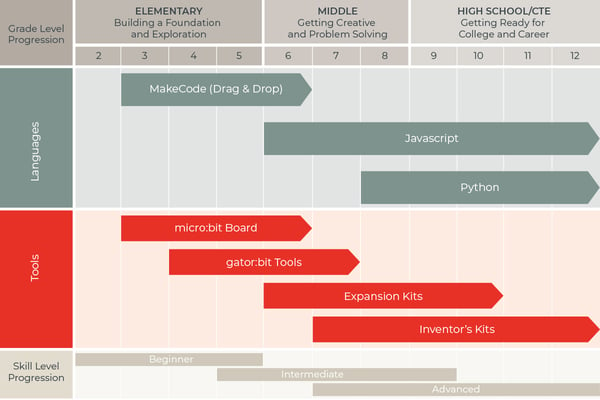I see it over and over again when I tour a school district - I walk into a middle or high school technology classroom and see students doing amazing work with different tools and product sets from many brands, all using different programming languages, environments and parts that only work with their own brand. This creates a hodgepodge of experiences and a nightmare for the teacher to manage. From making sure the software for everything is installed correctly, to drivers, parts and learning outcomes, it's a miracle the teacher is functioning!
A Product Ecosystem Approach
Here at SparkFun we are used to thinking about things in terms of an “ecosystem” – how products work with one another, are programmed in the same language or conceptually flow from one product to the other without the need to learn the same “Hello world” moment over and over again.
When we develop a product especially for the education market, we think long and hard about how a teacher would use that product. We map out what other products it works with and, more importantly, we look at the longevity of use, both in terms of durability and in terms of the products being able to span multiple grades and multiple subjects. In essence, we look at the value we can provide to a school as a whole, rather than just as a standalone product.
Our ultimate goal is to provide a product ecosystem that a student could start with in third grade and use all the way through their senior year of high school. This simplifies learning goals, aligning them across grades and schools, and builds technical skills and abilities rather than students getting stuck on a seesaw of programming languages and hardware.
An Example with micro:bit
A great example of our focus on this topic are our product offerings around the micro:bit. The micro:bit has been around for just over two years now and we are excited to see its growth in the K-12 education space. With a school district's blank slate, here is the general idea we would pitch.
3rd - 5th Grade
At an introductory level, we would recommend teaching programming and using the micro:bit no younger than third grade. This is a key age for starting students to program; any younger and you run up against their evolving abilities to read.
When students get a handle on the micro:bit by itself, they will quickly be ready to expand their capabilities in the world of circuits and electricity by incorporating alligator clips and simple sensors with the micro:bit or the SparkFun gator:bit.
6th - 8th Grade
As students transition to middle school, they usually have a dedicated technology course they can take as an elective. Depending on the focus of the technology class, this is where students start to use the micro:bit as a transferable brain to control a number of different projects and applications.
We tend to recommend our application based kits for this age group so they can leverage their imagination on how to use the micro:bit as the heart of different projects. We have three different kits based around assembling and programming a weather station, building a robot or creating games and game controllers. These kits expand the functionality of the micro:bit by adding extra parts through the use of what we call “carrier boards.” The micro:bit plugs directly into these boards, and we have developed software programming packages for Microsoft MakeCode that make using them a snap. These kits are also a great path into integrating the micro:bit into other STEM subject classrooms, such as building and using a weather station in your science classroom!
8th - 12th Grade
As students build their knowledge of the micro:bit, at some point they will want/need to develop their own circuits, and integrate sensors and actuators that we don’t have a carrier board for. They are ready to really dive into the world of breadboarding and electronics. For this application, we developed the SparkFun Inventor’s Kit for micro:bit. This kit breaks out all of the pins on the micro:bit and makes it breadboard friendly so your students can start to learn how to prototype circuits, build their own projects and unlock the full potential of the micro:bit. If you are a little unsure about integrating breadboarding into your classroom, we have a full online guide to walk you and students through it, and we offer professional development workshops for districts.
10th - 12th Grade
These grade levels are still something we are working on within the micro:bit ecosystem. For many high school students at this level, the SparkFun Inventor’s Kit for micro:bit is going to give them enough to keep going down the rabbit hole of cool things to do with micro:bit. Topics like radio communication between two or more micro:bits, exploring advanced sensors, Bluetooth communication, building phone apps to control the micro:bit and even integrating the micro:bit with a chrome app for schools doing web development are all choices. To to be honest, the sky's the limit.
If you are really adventurous, I highly recommend looking into using maker.makecode.com with our SAMD21 Breakout boards. It does take some leg work (you have to add a new bootloader on the board) and soldering, but it gives you access to programming an Arduino-compatible board in MakeCode, and leverages a lot of what the SAMD21 chip has to offer such as capacitive touch, Human Interface Device (works as a keyboard and mouse) as well as many, many more features.
Closing
In closing, we love talking about product ecosystems. This post doesn’t even touch on the other directions you can take the micro:bit ecosystem into in terms of programming languages, interfacing the micro:bit with other products, etc. If you are a teacher or a district administrator that sees what I saw at the beginning of this post happening in your schools, we would love to talk to you about simplifying your classroom technology, and in turn, empowering your students to learn and retain more knowledge and apply that knowledge across the curriculum. Please reach out to set up a consultation by emailing us at education@sparkfun.com



micro:bit, helpful information